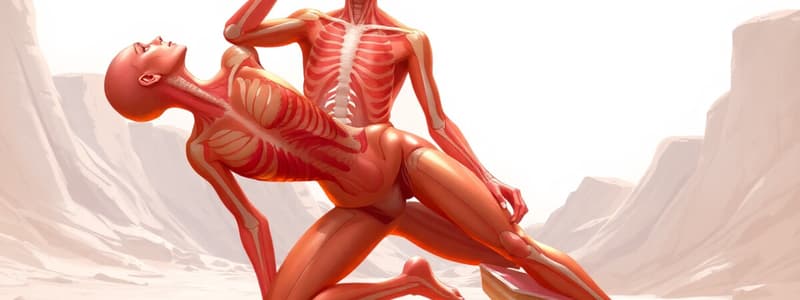Podcast
Questions and Answers
What does the median (sagittal) plane divide the body into?
What does the median (sagittal) plane divide the body into?
- Upper and lower halves
- Front and back parts
- Equal right and left halves (correct)
- Unequal vertical parts
Which statement accurately describes the paramedian plane?
Which statement accurately describes the paramedian plane?
- It is a horizontal plane dividing the body into upper and lower parts.
- It is parallel to the median plane and divides the body into unequal parts. (correct)
- It is a vertical plane that divides the body into equal halves.
- It passes through the middle of the body along the side.
What is another name for the horizontal plane?
What is another name for the horizontal plane?
- Paramedian plane
- Transverse plane (correct)
- Coronal plane
- Sagittal plane
What does the coronal (frontal) plane divide?
What does the coronal (frontal) plane divide?
When observing the anatomical planes in the diagram, which plane is indicated to be vertical?
When observing the anatomical planes in the diagram, which plane is indicated to be vertical?
What is the supine position?
What is the supine position?
Which position is described as lying on one's face?
Which position is described as lying on one's face?
How is the lithotomy position characterized?
How is the lithotomy position characterized?
What does the median (sagittal) plane do?
What does the median (sagittal) plane do?
What is the lateral decubitus position?
What is the lateral decubitus position?
Flashcards are hidden until you start studying
Study Notes
Anatomical Planes
- The median (sagittal) plane is a vertical plane that divides the body into equal right and left halves.
- The paramedian plane is a vertical plane parallel to the median plane, creating unequal vertical body parts.
- The coronal (frontal) plane is a vertical plane that divides the body into anterior (front) and posterior (back) parts.
- The horizontal plane, also known as the transverse plane, divides the body into upper and lower parts at any level.
Body Positions
- Supine: The body lies on its back.
- Prone: The body lies on its face.
- Lateral Decubitus: The body lies on its side, either right or left.
- Lithotomy: The body lies on its back with the hips and knees flexed, and the hips abducted.
Terms of Position
- Anterior (or Ventral): Towards the front of the body.
- Posterior (or Dorsal): Towards the back of the body.
- Superior: Towards the head.
- Inferior: Towards the feet.
- Cranial: Towards the head.
- Caudal: Towards the tailbone.
- Medial: Towards the midline of the body.
- Lateral: Away from the midline of the body.
- Proximal: Closer to the point of attachment of a limb.
- Distal: Further from the point of attachment of a limb.
Terms of Number
- Uni- / Mono-: One
- Bi- / Di-: Two
- Tri-: Three
- Quadri-: Four
- Multi- / Poly-: Many
- Oligo-: Little
Superficial Fascia
- A layer of loose connective tissue located just beneath the skin.
- Connects the skin to the underlying structures.
- Contains a variable amount of fat, with more presence in females than males.
Superficial Fascia: Functions
- Thermal Insulation and Energy Storage: Retains body heat and stores energy due to the presence of fat.
- Conductive Medium: Provides a pathway for nerves, blood vessels, and lymphatic vessels supplying the skin.
- Subcutaneous Muscles: Contains subcutaneous muscles, including those in the face, neck, and scrotum.
Deep Fascia
- A membrane composed of densely packed collagen fibers.
- Inelastic and well-defined in the limbs, but absent in the face and anterior abdominal wall.
Deep Fascia: Functions
- Formation of Broad Sheets: Surrounds and maintains the position of muscles and structures in the limbs.
- Separates Different Muscle Groups: Divides different muscle groups within the limbs.
Dartos Muscle
- Contains specialized glands like mammary glands, sweat glands, and superficial lymph nodes.
- Contributes to softening and smoothing the body surface.
- Facilitates skin movement over the underlying structures.
- Determines the size and contour of certain body parts, for example, the breast.
Palmaris Brevis
- A muscle found in the palm of the hand.
- Helps with fine motor skills and gripping.
Anatomical Positions
- Erect Anatomical Position: The standard position of the body, standing erect with specific features.
- Upper limbs hanging by the sides, palms facing forward.
- Thumbs laterally positioned (pointing outwards).
- Lower limbs close together along the mid-line.
- Supine: Body lying on its back.
- Prone: Body lying on its face.
- Lateral Decubitus: Body lying on its side (right or left).
- Lithotomy: Body lies on its back with flexed hips and knees, and abducted hips.
Studying That Suits You
Use AI to generate personalized quizzes and flashcards to suit your learning preferences.




